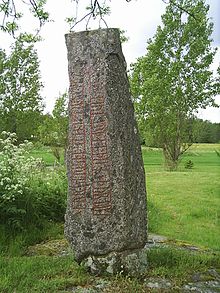Velandasten
The Velandasten (Vg 150) is a rune stone from the Viking Age from the late 10th century or around the turn of the millennium. It is in Skattegården west of road 42, south of Väne-Åsaka in Trollhättans municipality in Västergötland in Sweden .
The stone was discovered in the 1910s as a construction in a wall in the immediate vicinity of today's installation site. The original place of origin is unclear, but is presumed to be in the immediate vicinity of Velanda. The 1.9 m high stone made of gneiss has an average width of 0.4 to 0.5 m and is 0.25 to 0.5 m thick. The decoration consists of a straight, curved rune band, corresponding to the narrow, high shape of the stone. The top is crowned with an eagle's head. The inscription in the younger 16-type Futhark is executed clockwise with 9 to 12 cm high runes .
- × þurui: risþi: stin: iftiR: ukmut: buta: sin: miuk: kuþan: þikn × þur: uiki ×
- Þyrvé travels stone eptir Ôgmund, bónda sinn, mjôk góðan þegn. Þórr vígi.
- Þyrvé erected the stone in memory of Ôgmundr, her husband, a very good Þegn. Þórr ( Thor ) consecrate (the runes, the stone?).
The stone lacks the Christian cross and the corresponding dedication. It appears to have been set up for a pagan man. The call of the god Thor ( þur: uiki ) makes the stone almost unique in Sweden. There are only two similar calls from Thor on runestones in Sweden: Ög 136 in Rök and Sö 140 in Korpbron . Danish rune stones containing invocations or dedications to Thor are more common; including DR 110 from Virring , DR 209 from Glavendrup and DR 220 from Sønder Kirkeby .
The word þegn has a broader meaning in the Viking Age inscriptions, which is currently evaluated and interpreted differently in research. Accordingly, the term is used to denote a “free man”, “landowner” or as that of a (noble) “follower”.
literature
- Klaus Düwel : Runic lore. 4th, revised. u. act. Edition. Metzler, Stuttgart 2008, ISBN 978-3-476-14072-2 , p. 100.
- Anders Hultgård : Runic inscriptions and rune monuments as sources of religious history. In: Klaus Düwel (Ed.): Runic inscriptions as sources of interdisciplinary research. (= Reallexikon der Germanischen Altertumskunde - supplementary volumes . Volume 15). Walter de Gruyter, Berlin / New York 1998, ISBN 3-11-015455-2 , pp. 715-737.
- Judith Jesch: Runes and Words. Runic Lexicography in Context. In: Futhark. International Journal of Runic Studies. 4, 2013, pp. 77-100.
- Lena Peterson: Lexicon över urnordiska personnamn. Institut för språk och folkminnen, Uppsala 2004.
- Birgit Sawyer: The Viking Age Runestones, Custom and Commemoration in Early Medieval Scandinavia. Oxford University Press, Oxford 2000, ISBN 0-19-820643-7 .
- Elisabeth Svärdström: Västergötlands Runinskrifter. Fjärde Häftet: Älvsborgsläns including Göteborgs och Bohusläns Runstenar. (= Sveriges Runinskrifter. 5). Almqvist & Wiksells Boktryckeri AB, Uppsala 1958, pp. 279f.
Web links
- Velandasten - entry in the database "Fornsök" des Riksantikvarieämbetet (Swedish)
Remarks
Coordinates: 58 ° 12 '59.9 " N , 12 ° 25' 27.9" E

